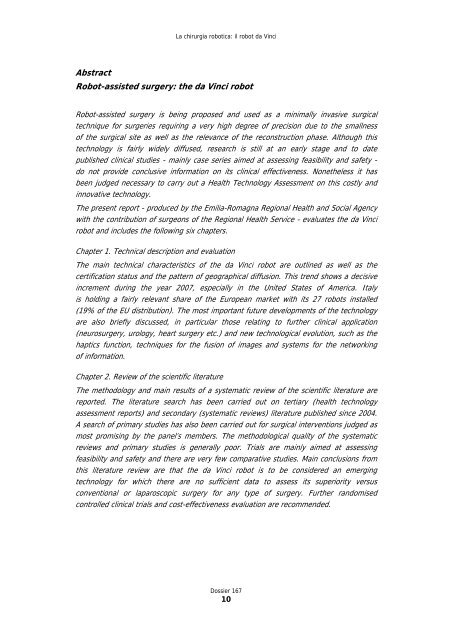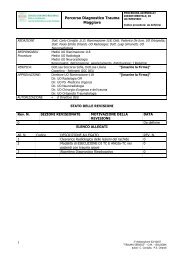La chirurgia robotica - Agenzia sanitaria e sociale regionale ...
La chirurgia robotica - Agenzia sanitaria e sociale regionale ...
La chirurgia robotica - Agenzia sanitaria e sociale regionale ...
Create successful ePaper yourself
Turn your PDF publications into a flip-book with our unique Google optimized e-Paper software.
Abstract<br />
<strong>La</strong> <strong>chirurgia</strong> <strong>robotica</strong>: il robot da Vinci<br />
Robot-assisted surgery: the da Vinci robot<br />
Robot-assisted surgery is being proposed and used as a minimally invasive surgical<br />
technique for surgeries requiring a very high degree of precision due to the smallness<br />
of the surgical site as well as the relevance of the reconstruction phase. Although this<br />
technology is fairly widely diffused, research is still at an early stage and to date<br />
published clinical studies - mainly case series aimed at assessing feasibility and safety -<br />
do not provide conclusive information on its clinical effectiveness. Nonetheless it has<br />
been judged necessary to carry out a Health Technology Assessment on this costly and<br />
innovative technology.<br />
The present report - produced by the Emilia-Romagna Regional Health and Social Agency<br />
with the contribution of surgeons of the Regional Health Service - evaluates the da Vinci<br />
robot and includes the following six chapters.<br />
Chapter 1. Technical description and evaluation<br />
The main technical characteristics of the da Vinci robot are outlined as well as the<br />
certification status and the pattern of geographical diffusion. This trend shows a decisive<br />
increment during the year 2007, especially in the United States of America. Italy<br />
is holding a fairly relevant share of the European market with its 27 robots installed<br />
(19% of the EU distribution). The most important future developments of the technology<br />
are also briefly discussed, in particular those relating to further clinical application<br />
(neurosurgery, urology, heart surgery etc.) and new technological evolution, such as the<br />
haptics function, techniques for the fusion of images and systems for the networking<br />
of information.<br />
Chapter 2. Review of the scientific literature<br />
The methodology and main results of a systematic review of the scientific literature are<br />
reported. The literature search has been carried out on tertiary (health technology<br />
assessment reports) and secondary (systematic reviews) literature published since 2004.<br />
A search of primary studies has also been carried out for surgical interventions judged as<br />
most promising by the panel’s members. The methodological quality of the systematic<br />
reviews and primary studies is generally poor. Trials are mainly aimed at assessing<br />
feasibility and safety and there are very few comparative studies. Main conclusions from<br />
this literature review are that the da Vinci robot is to be considered an emerging<br />
technology for which there are no sufficient data to assess its superiority versus<br />
conventional or laparoscopic surgery for any type of surgery. Further randomised<br />
controlled clinical trials and cost-effectiveness evaluation are recommended.<br />
Dossier 167<br />
10



